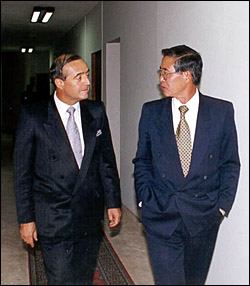Vladimiro Montesinos and the Art of the Bribe
By Jason Felch and Michael Montgomery
Part 1, 2, 3, 4
 | Vladimiro Montesinos (left)
and Alberto Fujimori (right) |
With U.S. support, Peru captured the head of the Shining Path guerrillas. That victory helped Alberto Fujimori secure two re-elections. But in 2000, it all started to unravel. Montesinos' penchant for taping his deals proved his undoing. A tape showing Montesinos bribing a Peruvian congressman aired on a cable station in Peru. Montesinos fled the country and within months, Fujimori's government collapsed. While ex-President Fujimori took up residence in Japan, where he is a dual citizen, Montesinos was captured, extradited to Peru and locked up at a sprawling naval base ten miles north of Lima.
Montesinos is on trial in a courtroom here. Journalist Sally Bowen co-authored a book about Montesinos and has been covering the trials since they began in 2001.
"Now this is famous or infamous because here is where Montesinos himself had built six cells to house Peru's most dangerous terrorists, including Abimail Guzman," says Bowen. "And now, very paradoxically, Montesinos is in a cell alongside Abumail Guzman, the man he hunted down."
Montesinos, and hundreds of others, are facing 79 separate indictments in one of the biggest series of corruption trials ever mounted. On this day, Montesnios watches stoically in a brown suede jacket as the presiding judge talks with defense lawyers who are about to question a witness. It's just part of a huge crackdown on corruption.
"We have generals, head of the armed forces, colonels, high level media owners, electoral officials, some businesspeople," says Bowen. "I think you could probably say that these 1400 or 1500 people implicated in the Montesinos network cover the entire gamut of Peruvian society."
Montesinos' videos have been invaluable to prosecutors, so it's puzzling why he made such a potentially damaging body of evidence to begin with. Some experts say the videos fed Montesinos' addiction to power and his belief that he would never be caught.
Stanford professor John McMillan says another reason was simple bookkeeping.
"He's got 1600 people at least that he's bribing," says McMillan. "You can't keep this in your head. You need records."
Some of the videos reveal not just Monteinos' deals with Peruvians but his warm relations with the CIA . In one, Montesinos throws a party for the departing CIA station chief. In spite of this relationship, U.S. officials say they were as surprised as anyone by the scale of Montesinos' corruption when the videos came to light. But Peruvian journalist Gustavo Gorriti says the US should have known what Montesinos was up to, in part because reporters were writing about it.
"They decided not to know," says Gorriti, referring to U.S. officials. "Not to look into the matter deeply to try to look the other way and they were very efficient at that. 'Don't ask, don't tell' and they didn't ask but they were told and that's the interesting thing."
Montesinos has been convicted on some, lesser charges but the big trials lie ahead. The mass corruption has left many people deeply suspicious of Peru's new, democratically elected government and the country is again facing turmoil. Still, Peter Eigen of Transparency International sees a silver lining in cases like Montesinos' that garner huge publicity.
"There seems to be the perception now that there's more corruption than before, but I would say society is simply more vigilant," says Eigen. "And therefore there is an attempt to flush out misbehavior in the public sector and in the private sector. People simply do not trust their elites anymore."
Back to The Cost of Corruption
| 


